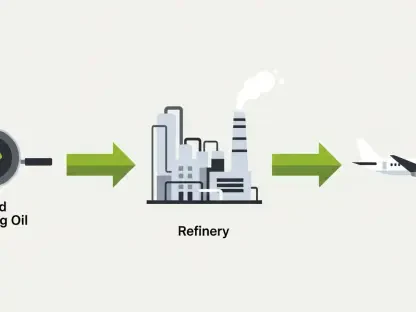In a bold move that could reshape the landscape of Canada’s oil sands industry, Cenovus Energy has launched a C$7.9 billion ($5.68 billion) cash-and-stock bid to acquire MEG Energy, positioning itself as a defender against a hostile takeover attempt by Strathcona Resources. This significant transaction, unveiled recently, aims to create one of the largest oil sands producers in the region with a combined production capacity surpassing 720,000 barrels per day (bpd). The deal not only highlights the ongoing consolidation within the sector but also underscores the fierce competition for control over valuable assets in northern Alberta. As the offer awaits shareholder approval with an anticipated closure in the coming months, the stakes are high for Cenovus to solidify its dominance. This acquisition could set a precedent for future mergers in the energy sector, raising questions about market dynamics and strategic growth in a challenging global energy environment.
Strategic Expansion in Oil Sands
The core of Cenovus Energy’s acquisition strategy lies in expanding its oil sands footprint through the integration of MEG Energy’s operations, particularly the Christina Lake project in northern Alberta. By merging these assets with its adjacent holdings, Cenovus aims to enhance production efficiency through improved steam-to-oil ratios and cutting-edge well designs. The goal is ambitious: to elevate Christina Lake’s output to over 150,000 bpd within the next few years, while pushing total oil sands production beyond 850,000 bpd in the same timeframe. This synergy is seen as a cornerstone of the deal, promising not just immediate operational benefits but also long-term growth potential. Cenovus’ leadership has emphasized that such integration will streamline costs and boost overall capacity, positioning the combined entity as a formidable player in the industry amidst fluctuating oil prices and regulatory pressures.
Beyond operational synergies, the acquisition represents a calculated move to strengthen Cenovus’ market position in a highly competitive sector. The oil sands region remains a critical area for energy production in Canada, and securing MEG Energy would provide Cenovus with a significant edge over rivals. This deal comes at a time when global demand for energy continues to evolve, with increasing focus on sustainable practices. While the immediate focus is on ramping up production, there is also an underlying need to balance growth with environmental considerations. The market has responded positively to this strategic vision, as evidenced by a more than 4% rise in Cenovus’ shares following the announcement. However, the true test lies in whether these projected efficiencies can be realized in practice, given the complex nature of oil sands extraction and the external challenges facing the industry.
Competitive Dynamics and Shareholder Sentiment
The acquisition of MEG Energy is not without its challenges, as it unfolds against the backdrop of persistent rivalry with Strathcona Resources, which previously made a C$6 billion hostile bid that MEG’s board rejected as insufficient. After that rejection, MEG sought alternative offers, leading to Cenovus stepping in as a white knight with a more attractive proposal of C$27.25 per share, a 27.9% premium over the pre-bid closing price. Despite this, Strathcona remains undeterred, with plans to engage MEG shareholders directly before their tender deadline. This ongoing competition highlights a broader trend of consolidation in the Canadian energy sector, where companies are aggressively pursuing scale to enhance production and market share. The tension between the two suitors adds a layer of uncertainty to the deal, making shareholder sentiment a pivotal factor in the outcome.
Analysts have noted that Cenovus’ offer, comprising 75% cash and 25% stock, may hold greater appeal for MEG shareholders compared to Strathcona’s bid, due to the immediate financial benefits it provides. However, there is speculation that Cenovus might need to sweeten its offer before the upcoming shareholder vote to ensure approval. The equity valuation of MEG at roughly C$6.93 billion, along with assumed debt, reflects the substantial financial commitment Cenovus is making. Beyond the numbers, the deal’s success will depend on how well Cenovus can communicate the long-term value of operational synergies and growth potential to investors. As the vote approaches, the energy sector watches closely, aware that the outcome could influence future takeover battles in the region and reshape competitive dynamics for years to come.
Navigating Uncertainties and Future Prospects
Reflecting on the developments, Cenovus Energy’s bid for MEG Energy marks a critical juncture in the oil sands industry, showcasing a strategic effort to counter a hostile takeover while pursuing aggressive growth. The focus on integrating operations and boosting production capacity stands as a testament to Cenovus’ commitment to becoming a leading producer. Yet, the persistent challenge from Strathcona Resources and the need for shareholder approval underscore the complexities of such high-stakes corporate maneuvers.
Looking ahead, the path forward for Cenovus involves not only securing the necessary votes but also delivering on the promised operational efficiencies. Stakeholders should monitor how the company addresses potential regulatory hurdles and market fluctuations while integrating MEG’s assets. Additionally, exploring sustainable practices alongside production growth could enhance long-term viability. The resolution of this deal will likely serve as a benchmark for future consolidations, offering lessons on balancing competitive pressures with strategic ambitions in the ever-evolving energy landscape.









